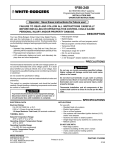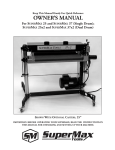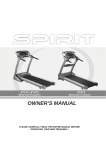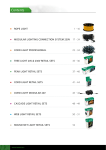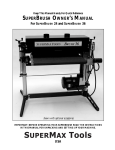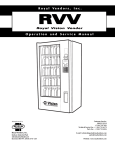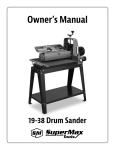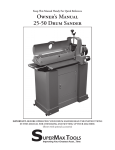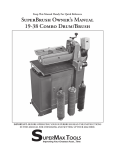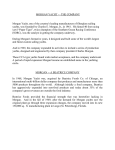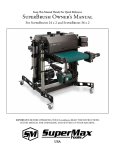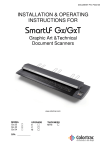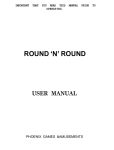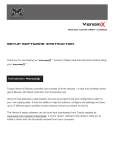Download User Manual - SuperMax Tools
Transcript
Keep This Manual Handy For Quick Reference SHOPPRO 25 OWNER’S MANUAL SHOWN WITH OPTIONAL CASTERS, INFEED/OUTFEED TABLES, RACK-N-ROLL AND PRE MARKED ABRASIVES IMPORTANT: BEFORE OPERATING YOUR SHOPPRO 25 READ THE INSTRUCTIONS IN THIS MANUAL FOR UNPACKING AND SETTING UP YOUR MACHINE U.S.A. 2 SHOPPRO 25 OWNER’S MANUAL CONGRATULATIONS CAUTION, SAFETY FIRST You have made a wise purchasing decision by adding this “Made In USA” machine to your tool line-up. The main purpose in inventing and developing the machine you’ve purchased was to bring a new dimension of productivity to your workshop, be it large or small. Right from the start, our goal at SuperMax Tools has been to manufacture equipment that is capable of providing you with maximum economy, maximum utility, and maximum performance. Your SuperMax Tools drum sander will pay you back many fold in the years ahead by helping you get better results in less time, start to finish. This tool incorporates a bundle of exclusive features which you will appreciate more every time you use it. All SuperMax Tools drum sanders feature patented self-cooling drums and spring-tension abrasive take-up fasteners, as well as sealed and permanently lubricated bearings. The exclusive SuperMax Tools variable-speed power feed conveyor system provides you with ultra-precise control, whether you are surfacing rough-sawn lumber, dimensioning otherwise unusable stock, cleaning up glued panels, or finish sanding either thick stock or the thinnest veneers. SuperMax Tools and its dealers are committed to providing you with innovative solutions, from selecting the right machine to helping you get top performance when you put it to work in your shop. Regardless of how you take advantage of these innovations, we are confident our equipment will help bring you a giant step forward in precision shop productivity. When maintaining and operating this machine, always put safety first. For your own safety, read and understand this owner’s manual before operating this machine. Always heed and follow all normal safety precautions, including the following: • Always wear eye protection while operating the sander. • Always feed stock against the drum rotation. • Never place hands or fingers under the drum or dust cover. • Keep hands and clothing away from operating drums. • Never operate the sander without its dust cover or drum and belt guarding in place. • Always maintain control of boards to avoid kickback; know how to prevent it. • Always disconnect electrical power before doing any servicing or adjusting of the machine. MODEL IDENTIFICATION Your SHOPPRO 25 drum sander is one of a family of machines from SuperMax Tools designed to help you achieve results comparable to industrial-size sanders at a fraction of the cost. For future reference, attach the Model/Serial # Bar Code label below or find the model and serial numbers on the front table mount (#20, page 35) and write them in below. Model:_________________________________ Stock Number: __________________________ Serial Number: __________________________ Date Purchased: _________________________ Dealer:_________________________________ IMPORTANT : KEEP THIS MANUAL HANDY Please read this manual first. It was designed to help you get the most from your SHOPPRO 25 drum sander. Before unpacking or using the machine, familiarize yourself with its components, features, and basic adjustments by reviewing the following pages. You will find it an invaluable aid in setting up, operating and servicing your machine. If, after reviewing this manual, you still have a problem you can’t solve, please call your SuperMax Tools dealer. MANUAL CONTENTS 3 CONTENTS ABOUT THE SHOPPRO 25 SYSTEM SHOPPRO 25 Nomenclature ......................4 Unpacking Your SHOPPRO 25 Sander .......5 SETTING UP YOUR SHOPPRO 25 Making Electrical Connections .................6 Connecting Dust Collectors .....................6 Checking For Machine Level ....................6 Checking Drum Alignment ......................7 Checking The Conveyor Belt ...................7 Checking Table Height Controls ..............8 Monthly Maintenance ..............................8 Wrapping Abrasive Strips..........................9 OPERATING YOUR SHOPPRO 25 Basic Operating Procedures ....................11 SHOPPRO 25 Operating Controls............11 Setting The Depth of Cut.......................12 Setting Drum .........................................12 Using The Depth Gauge.........................13 Selecting Drum Abrasives .......................14 Tips For Maximum Performance ............14 TROUBLESHOOTING YOUR SHOPPRO 25 Troubleshooting Guide: Motors..............17 Troubleshooting Guide: Machine ...........18 Troubleshooting Guide: Operations........20 SERVICING YOUR SHOPPRO 25 Adjusting Height Controls......................22 Adjusting Table Support Castings ...........23 Adjusting Sanding Drum........................24 Adjusting Tension Roller ........................25 Replacing Sanding Drum .......................26 Replacing Conveyor Belt ........................28 Replacing V-Belt ....................................29 Replacing Drum Bearings .......................30 Replacing Electrical Components ...........33 Electrical Diagram ..................................33 SHOPPRO 25 TECHNICAL DATA Parts List For SHOPPRO 25 Stand............34 Parts List For Drum Assembly ................36 Parts List For Conveyor Assembly...........38 SHOPPRO 25 Specifications .....................40 SHOPPRO 25 Accessories & Supplies .......41 FOR YOUR SAFETY: Read all instructions carefully, and note the safety cautions on the opposite page and on the back cover of this manual. 4 SHOPPRO 25 OWNER’S MANUAL ABOUT THE SHOPPRO 25 SYSTEM This manual is designed to help you get familiar with your SHOPPRO 25 drum sander, and to help you take advantage of its exclusive features. By understanding its major components, and how they work together, you will be able to get the most from your investment. The SHOPPRO 25 system is basically made up of the following five major com-ponents: 1) precision machined revolving drum wrapped with abrasive strips held by a 2) patented take-up mechanism to process stock fed by the 3) no-give conveyor table which is adjusted by 4) an infinitely variable power feed motor and a 5) convenient height adjustment mechanism. The illustration below (Fig. 1) shows the major components. DUST COVER HEIGHT ADJUSTMENT HANDLE SANDING DRUM TENSION ROLLER DEPTH GAUGE FEED CONVEYOR CONTROL BOX MITER GEARS (HEIGHT ADJUSTMENT) CONVEYOR GEAR MOTOR LEFT (OUTBOARD) SIDE RIGHT (INBOARD) SIDE MAIN MOTOR Fig. 1. SHOPPRO 25 nomenclature. ABOUT THE SHOPPRO 25 SYSTEM 5 UNPACKING YOUR SHOPPRO 25 Your SHOPPRO 25 sander has been shipped completely assembled from the factory in a cardboard shroud on a pallet and shrink-wrapped in plastic. If any damage has occurred as a result of shipment, notify the transportation company as soon as possible and ask them to make an immediate inspection. Ask for a damage or loss report. Also notify your dealer of any loss or damage during shipment. See enclosed Warranty Statement. Important: To avoid problems and potential damage to the machine, please read through the unpacking instructions below before proceeding to set up the machine in your shop. 1. Unbolt the machine legs from the shipping pallet. Install the rubber-based leveling feet on legs (Fig. 2). The glides and mounting hardware are in the STOP envelope packed with your machine. 2. Loosen the hex nut and set screws on the table support castings (Fig. 3). The set screws on the table support castings have been tightened at the factory to eliminate free-play between the table support casting and the column tube during shipment. There are two table support castings on the SHOPPRO 25, one each for the right and left column tubes. Important: These set screws are tightened for shipping and must be loosened and readjusted before operating either the height adjustment mechanism or the conveyor drive. To properly adjust for operation, loosen each set screw by first loosening its hex nut with an openend wrench and then the set screw with an Allen wrench. Then retighten each set screw with your fingers so it only lightly touches the column tube. Hold each set screw in position with an Allen wrench and retighten the hex nut. Failure to follow these procedures may result in misalignment of the drum and/or the conveyor table. Caution: On the SHOPPRO 25 models do not loosen the set screws on the upper drum support castings. 3. Install the power feed gear motor (Fig. 6). Rotate the drive roller on the conveyor system so the flat part of the shaft is down. If necessary, plug the gear motor into an appropriate 110v AC outlet to rotate the motor output shaft coupling so the set screws face downward. Unplug the gear motor. Slide the power feed motor assembly onto the drive roller shaft, aligning the shaft coupling and four mounting holes. Start the four 5/16" hex head bolts on the power feed motor mounting bracket, but do not tighten yet. Next, tighten the set screws in the coupling on the drive roller shaft, making sure they are on the flat of the shaft. Rock the drive roller while tightening the set screws to make sure they are centered properly on the flat. Install the safety shield on the bottom of the assembly with two screws. Then plug in the cord and turn conveyor on full speed. While it is running, tighten the four 5/16" bolts to secure the motor assembly in place. 4. Adjust the tension of the V-belt between the primary motor and driven pulleys, if necessary. To do this, loosen the two screws in lower belt guard and loosen the pinch bolt located at the back of the motor support casting. Slide the motor support casting down the column tube until the V-belt is taut. Tighten the two screws in lower belt guard. Retighten the motor support pinch bolt. Plug the 1 1/2-hp motor into the outlet on the power feed motor assembly. TABLE SUPPORT CASTING STAND LEG LEVELING FOOT Fig. 2. Leveling feet and mounting hardware. HEX NUT & SET SCREWS Fig. 3. Table support casting and set screws. 6 SHOPPRO 25 OWNER’S MANUAL SETTING UP YOUR SHOPPRO 25 CONNECTING DUST COLLECTORS Your SHOPPRO 25 drum sander was adjusted and aligned at the factory, and it has been carefully packed for shipment. However, because of possible stress during transit, the unit should be thoroughly checked before being put to use. This section covers the pre-operational checks you should make after unpacking and final assembly. Unnecessary problems can be avoided if these essential checks are performed before operating the sander. Likewise, performing the recommended monthly maintenance procedures listed at the end of this section will help assure trouble-free service. Dust collection is necessary for SHOPPRO 25. The SHOPPRO 25 is equipped with one 4"-diameter dust exhaust port at the top of the drum cover. To attach the SHOPPRO 25 to your collection system, install 4" hose from your collector. (See Tips For Maximum Performance, page 14 of this manual.) The minimum recommended dust collector capacities at the dust port is 600 CFM. For best results, follow the recommendations of the manufacturer of your dust collection equipment. CHECKING MACHINE FOR LEVEL MAKING ELECTRICAL CONNECTIONS Proper leveling of the machine is essential to achieve continued maximum performance from the SHOPPRO 25. Before making fine adjustments, place the unit where it will be used in the shop. Then adjust the four leveling feet using a carpenter’s level both across the machine and in line with the machine, placing the level on the conveyor bed. If you have equipped your SHOPPRO 25 with the optional caster set, do the same after positioning the machine where it will be operated most often. Mark the position of the legs on the floor with tape so it can be returned to the same position. Power for the drum of your SHOPPRO 25 sander is supplied by a single phase 1 1/2-hp, 110-volt motor. A plug is provided on the cord from the motor which plugs into the outlet on the conveyor motor assembly, and also on the cord which runs from the assembly to your receptacle. The single phase motor will require a dedicated circuit of 10-gauge wire protected by a 20-amp minimum fuse or breaker. Any extension cords used should be of at least 12-gauge wire for lengths of up to 10´ and of at least 10-gauge wire for lengths between 10´ and 25´. Fig. 5. SHOPPRO 25 Components. 1 4 2 3 5 4 6 6 10 9 7 8 1. Height Adjustment Handle. 2. Adjusting Screw Support. 3. Drum Support Casting. 4. Height Adjusting Screw. 5. Table Support Casting. 6. Adjusting Screw Support. 7. Miter Gear. 8. Motor Support Casting. 9. Transfer Rod. 10. Shaft Collars. SETTING UP YOUR SHOPPRO 25 7 CHECKING DRUM ALIGNMENT Your SHOPPRO 25 was shipped from the factory preadjusted with the drum aligned to the conveyor table. Unless the machine was stressed during shipment, only fine adjustment should be necessary. Minor alignment corrections can be done without relieving V-belt tension or adjusting the tension rollers, but should be done without any abrasive strips attached. Using a flat piece of wood or metal as a thickness gauge, insert it between the conveyor table and the drum on the left (outboard) side of the machine (see Fig. 7). Raise the table up so the drum just contacts the thickness gauge. Then holding up the front tension roller, check both sides of the drum with the thickness gauge to verify that the drum is parallel to the table. If it is not, disengage the right (inboard) miter gear (see Fig. 8), finely raise or lower the right (inboard) side of the table to achieve parallel alignment of the drum. The distance between the conveyor table and both sides of the drum should be the same. Reinstall the miter gear, aligning the set screw to the flat of the shaft. CHECKING THE CONVEYOR BELT Conveyor belt tension and tracking adjustments may occasionally be necessary during break-in and normal operation to compensate for belt stretching. Belt Tension. To adjust the tension of the conveyor belt, first adjust the take-up screw nut (see Fig. 10) on both sides of the conveyor to obtain approximately equal tension on both sides of the belt when taut. Insufficient belt tension will cause slippage of conveyor belt on the drive roller during sanding operation. The conveyor belt is too loose if it can be stopped by hand pressure applied directly to the top of the conveyor belt. Excessive belt tension can result in bent rollers, premature wearing of the bronze bushings or belt. Belt Tracking. Belt tracking adjustments are made while the conveyor belt is running. After the proper belt tension is obtained (see above), turn the conveyor unit on and set it at the fastest speed setting. Watch for a tendency of the conveyor belt to drift to one side of the conveyor. To adjust the belt tracking, tighten the take-up screw nut (see Fig. 10) on the side the belt is drifting toward, and loosen the take-up screw nut on the opposite side. Adjusting the take-up screw nuts on either side of VARIABLE SPEED CONTROL DRUM SWITCH Fig. 6. Conveyor Controller. the conveyor allows belt tracking adjustments to be made without affecting belt tension. NOTE: Adjust the take-up screw nuts only 1/4 turn at a time. Then allow time for the belt to react to the adjustments before proceeding further. Try to avoid over-adjustments. Make sure wrench is below surface when sanding. Fig. 7. Checking drum alignment (outboard side). 8 SHOPPRO 25 OWNER’S MANUAL INBOARD MITER GEAR TAKE-UP SCREW NUT Fig. 8. Adjusting drum alignment. Fig. 10. Adjusting conveyor belt tracking. CHECKING TABLE HEIGHT CONTROLS • Lubricate conveyor bushings and check for wear. • Lubricate all moving parts, such as threaded rods, washers, and column tubes. • Clean sawdust from the sandpaper and the conveyor belt. • Blow dust from the inside of sanding drum and the motors. • Check all set screws for tightness on parts such as table support castings, bearings, conveyor coupler, castings, pulleys, and miter gears. HEIGHT The table height and depth of cut are controlled by the height adjustment handle (see Fig. 11). Turning the handle raises or lowers both sides of the table simultaneously by transferring the handle rotation through the miter gear and cross bar assembly. Important: Before using the height adjustment, be sure to loosen both the set screws located on the front of both table support castings (see Fig. 3 and Fig. 11) to allow the table support to slide on both column tubes. These set screws are tightened for shipping and must be loosened and readjusted to allow the table support castings to move freely on the column support tubes. Readjust the set screws just so they eliminate free-play between the table support casting and the column tube. To properly adjust, tighten the set screws (see Fig. 3) only fingertight so they lightly touch the column tubes. Then hold each set screw in position with an Allen wrench and tighten the hex nut. Check the operation of the height adjustment mechanism. If it does not operate smoothly or easily, further adjustments may be necessary. Refer to the servicing section of this manual, which begins on page 22, for further adjustment procedures. ADJ. HANDLE DRUM SUPPORT CASTING TABLE SUPPORT CASTING HEX NUT & SET SCREW MITER GEAR MONTHLY MAINTENANCE For best results, perform the following recommended maintenance procedures on a monthly basis: Fig. 11. Table height adjustment mechanism. SETTING UP YOUR SHOPPRO 25 9 WRAPPING ABRASIVE STRIPS Note: When using SuperMax Tools “Pre-Cut™” or “Pre-Marked™” abrasives, not all of the steps below are necessary. Proper attachment of the abrasive strip to the drum is critical to achieving top performance from your Performax drum sander. Abrasive strips do not have to be pre-measured. The end of the roll is first tapered and attached to the left (outboard) side of the drum. Then the strip is wrapped around the drum, and the second taper is made for attachment to the right (inboard) side of the drum. To attach a strip to the drum, follow the procedure below. 1. Mark and cut a taper at one end of the roll as shown in Fig. 12-a. Because the tapered end should use most of the left (outboard) slot width, its end must be trimmed (Fig. 12-b and 12-c). Raise the clip lever on the left (outboard) side of the drum (Fig. 12-d). Insert the tapered end through the slot and into the fastener so that it uses most of the width of the slot. Release the clip lever to securely hold the strip end in the fastener. 2. Wrap the strip around the drum, being careful not to overlap the windings. The tapered cut of the strip end should follow the edge of the drum. Continue to wrap the abrasive in a spiral fashion by rotating the drum with your left hand and guiding the strip with your right hand (Fig 12-e). Successive windings of the strip should be flush with previous windings without any overlap. 3. Mark the trailing end of the strip where it crosses the right (inboard) end of the drum (Fig. 12-f ). From this point, cut a taper as was done with the starting edge of the strip. (The taper on the remaining roll can be used as the taper for the starting edge of the next strip to be cut.) cut, rewrap the drum and insert the tapered end through the slot in the right (inboard) end of the drum. Insert the tapered end into the inboard take-up fastener. Pull up on the clip lever to open the clip, and pull the take-up lever to the top as shown (Fig. 12-g). After inserting the strip end, release the clip lever by moving your index finger toward the drum slot. This allows the clip to retain the abrasive while holding the take-up lever in an “up” position. 5. The take-up fastener is designed to automatically take up any slack caused by stretching of the abrasive strip. Important: Position the abrasive strip in the slot with sufficient room between the inside of the slot and the tapered end of the strip to allow it to be pulled into the drum as needed (Fig.12-h). Note that not leaving enough space between the strip and the inside of the slot will prevent the take-up fastener from operating properly. 6. The abrasive strip may stretch enough in use to allow the take-up lever to reach its lowest position so it no longer is able to maintain tension on the strip (Fig. 12-i). If this occurs, it will be necessary to reset the take-up lever by raising it, pushing the strip end into the slot, and then releasing the clip lever. Note: A sandpaper cleaning stick may be used to remove deposits and help extend sandpaper life. To use, operate the sanding drum with the dust cover open. (Caution: For your own safety, always wear eye protection while performing sandpaper cleaning, and take all precautions to avoid any contact of hands or clothing with uncovered drums.) Hold the cleaning stick against the rotating drum and move it along the drum surface. It is good procedure to use a shop brush to remove any cleaning stick crumbs from the drums before resuming sanding operations. 4. With the trailing edge of the strip properly CU SANDPAPER STRIP (ABRASIVE SIDE UP) Also see Fig. 12-b and Fig. 12-c. Fig. 12-a. Marking and cutting taper on strip. TL INE S 153 /4" 3" Approx. 3" 10 SHOPPRO 25 OWNER’S MANUAL Fig. 12-b. Trim about 3" from end of cut taper. Fig. 12-c. Trimmed tapered end ready to install. Fig. 12-d. Insert tapered end into outboard slot. Fig. 12-e. Wrap strip around drum without overlap. Fig. 12-f. Mark strip where it crosses drum edge. Fig. 12-g. Insert tapered end into inboard slot. Fig. 12-h. Allow room inside slot for strip to move. Fig. 12-i. Reset take-up as needed as strip stretches. OPERATING YOUR SHOPPRO 25 11 OPERATING YOUR SHOPPRO 25 Before using your SHOPPRO 25 drum sander, review the previous pages in this manual on initial set-up and adjustment. In this section, you will learn how to operate the machine. Note that connecting the machine to an adequate dust collection system is necessary before operating the unit. BASIC OPERATING PROCEDURES After you have selected and installed abrasive strips, and connected the machine to a dust collection system, you are ready to begin to use the SHOPPRO 25. The basic operating procedure for the SHOPPRO 25 model is as follows (Fig. 13): 1. Set depth of cut. 2. Start drum. 3. Start conveyor and select feed rate. 4. Start dust collector system. 5. Feed stock through unit. To feed stock through the SHOPPRO 25, rest and hold the board to be sanded on the conveyor table, allowing the conveyor belt to carry the board into the drum. Once the stock is halfway through, reposition yourself to the outfeed side of the machine to receive and control the board as it exits the unit. HEIGHT ADJUSTMENT HANDLE SANDING DRUM FEED RATE CONTROL KNOB CONVEYOR SYSTEM DRUM SWITCH Fig. 13. SHOPPRO 25 operating controls. 12 SHOPPRO 25 OWNER’S MANUAL SETTING THE DEPTH OF CUT SELECTING FEED RATES Adjusting the SHOPPRO 25 for the proper contact between the abrasive and the stock determines the mechanical depth of cut. Determining the depth of cut is the most important set-up procedure when operating the SHOPPRO 25 sander. It may take some experimentation to determine the proper depth of cut, given the variables of abrasive grit, type of wood, and feed rate. For best results, use scrap wood to practice sanding and to develop skill and familiarity with the machine before doing finish work. A good rule of thumb when sanding is to raise the conveyor table so the drum contacts the workpiece but still can be rotated by hand. However, a combination of several variables will determine the proper depth of cut to use, including the following: Selecting the proper feed rate is essential to proper finish sanding. The variable feed rate control of the conveyor belt adjusts the load on the machine; it can be infinitely adjusted for maximum operating performance. A faster feed rate allows faster sanding but fewer revolutions of the drums per inch of sanding. A slower feed rate provides more revolutions of the drum per inch of sanding to allow a greater depth of cut and smoother sanding. Begin experimenting with the feed rate set at about 40% to 50% of maximum (Fig. 15). The best feed rate will depend on a number of factors, including type of stock, grit and depth of cut used, and whether the stock is fed directly in line with the conveyor bed or at an angle. If you observe a ripple effect on the stock, slow down the feed rate. If the finish is smooth and the machine is not overworking, you can experiment with using a faster feed rate. Also try a faster feed rate if the stock you are working begins to show burn marks. With cherry, hard maple and some other hardwoods, using a shallower depth of cut and a faster feed rate will help minimize burn marks. Slightly angling the stock as it is fed into the machine may also help prevent burning the stock. Because of the wide range of variables, it is important to experiment with your specific conditions and make adjustments to achieve the optimum feed rate. If problems occur, first check the depth of cut and/or adjust the feed rate. Refer to Troubleshooting Your SHOPPRO 25 in this manual, page 17. 1. Abrasive type and grit size. 2. Width of the piece being processed. 3. Hardness of the piece. 4. Feed rate of the conveyor belt. Your SHOPPRO 25 is a single drum model, the depth of cut is controlled by the table height adjustment handle which raises or lowers the conveyor table under the drum. To adjust the drum, set the drum height equal to the thickness of the piece to be processed. This is most easily done as follows: Lower the conveyor table to a depth greater than the thickness of the board. Do not start the drum at this time. Start the conveyor and feed the board beneath the drum. As the board is moving, raise the conveyor table until the board just engages the sanding drum. Watch the drive V-belt from the primary motor to know when the drum is engaged. Continue to run the board through the machine. From this position, raise the conveyor table to the proper depth of cut by turning the height adjustment handle in a clockwise direction. The depth of cut can be measured on the depth gauge, or by fractions of a revolution of the height adjustment handle. (Note: One revolution of the handle will raise the table 3/32 of an inch; 1/3 of a turn will equal 1/32 of an inch, etc.) OPERATING YOUR SHOPPRO 25 13 USING THE DEPTH GAUGE The depth gauge (see Fig. 16) measures the distance between the conveyor table and the sanding drum for thickness dimensioning of boards. To calibrate the depth gauge, loosen the locking knob of the lower depth gauge casting so it rests on top of the table support casting. Raise the conveyor table until it touches the sanding drum. Then loosen the locking knob of the upper depth gauge casting and position the “0” mark of the scale even with the top of the lower depth gauge casting. Lock the upper depth gauge casting in position. Once calibrated, the locking knob of the lower depth gauge casting can be loosened, allowing the lower depth gauge casting to ride on top of the table support casting. The depth can then be read where the scale enters the lower depth gauge casting. The depth gauge can also be used as a stop gauge as follows: Position the lower depth gauge casting along the scale to a desired finish thickness. Then lock the lower depth gauge casting with the locking knob to prevent the conveyor table from being raised above that point. CONVEYOR CONTROLLER DRUM SWITCH Fig. 15. Conveyor Controller. UPPER DEPTH GAUGE CASTING DEPTH GAUGE SCALE ROD LOWER DEPTH GAUGE CASTING TABLE SUPPORT CASTING Fig. 16. Depth gauge components. 14 SHOPPRO 25 OWNER’S MANUAL SELECTING DRUM ABRASIVES It is important to select the proper grit of abrasives for the type of sanding being performed to achieve maximum sanding results. As with any sanding operation, first begin sanding with a coarser grit, depending on the roughness of the stock or the amount of stock to be removed. Then progressively work toward finer grits. The chart below shows the general uses for the various grits. Performax Products offers abrasives in the nine different grits shown. Selecting Abrasive Grits. The amount of stock to be removed is a major consideration when choosing the grit grade to start with. Grits 24, 36, 60, and 80 are primarily designed for stock removal. Grits 24 and 36 will remove the most material in one pass, whether you are doing abrasive planing, cleaning up glued panels, or flattening stock. Grits from 100 through 220 are primarily finishing grits designed to remove the scratch pattern from the previous grit used. For best results, never skip more than one grit grade when progressing through a sanding sequence. For fine work, such as furniture, try not to skip any grit grades during the sanding process. In general, premium quality abrasives such as Genuine Performax abrasives will produce a better finish with a less noticeable scratch pattern. Caution: Grits that are too fine can sometimes burnish the wood and leave a glossy surface which will not accept stains evenly. This will vary by type of wood. Oak, for example, is susceptible to burnishing because of its open pores. TIPS FOR MAXIMUM PERFORMANCE The versatility designed into the SHOPPRO 25 drum sander allows it to be used for a wide-ranging variety of tasks that will boost the return on your investment. For example, its capabilities range from taking the place of a planer to thickness rough stock, all the way to speeding up fine sanding work often done with slower, dust-generating hand sanders. Learning to use its multiple adjustments and controls will allow you to fine-tune the machine for maximum results, regardless of the job to be done. The best results come from experimenting with different abrasive combinations and machine adjustments to fit the job at hand. Following is a listing of useful tips which can help you improve performance of your sander. ABRASIVE SELECTION GUIDE GRIT COMMON APPLICATION 24 Grit Abrasive planing, surfacing rough-sawn boards, maximum stock removal, glue removal. Abrasive planing, surfacing rough-sawn boards, maximum stock removal, glue removal. Surfacing and dimensioning boards, trueing warped boards. Surfacing, light dimensioning, removal of planer ripples. Light surfacing, removal of planer ripples. Light surfacing, minimal stock removal. Finish sanding, minimal stock removal. Finish sanding only, not for stock removal. Finish sanding only, not for stock removal. 36 Grit 60 Grit 80 Grit 100 Grit 120 Grit 150 Grit 180 Grit 220 Grit OPERATING YOUR SHOPPRO 25 15 Dust Collection. When connecting dust collectors, remember that straight pipe will not restrict airflow as much as flexible tubing. Also, Ys and elbows will restrict airflow less that Ts. Multiple-Piece Sanding Runs. When abrasive planing (or thickness sanding) a run of similar pieces that you want to have the same thickness, it is best to determine the thickness of the thinnest piece and process all pieces to that same thickness. Be aware that the sander will remove cups and crowns in the work piece; consider this when measuring and processing stock to the same thickness. Sanding Multiple Pieces At Once. When sanding multiple pieces simultaneously, make sure to stagger (step) the pieces across the width of the conveyor belt. This provides better contact with the tension rollers. Try to only process multiple pieces of similar thickness. If there is a significant thickness difference, the thinner pieces can slip on the conveyor belt if they do not contact the tension rollers. Also note that pieces thicker than 3/4" should be longer than the minimum normally recommended to prevent tipping of the stock (see Specifications, page 40). Edge Sanding. When edge sanding, the Performax sander will mimic the opposite edge of the stock which is laying on the conveyor belt. Because of this, it is important for the stock edge to have been ripped at the proper angle to the face before the sanding process. When edge sanding stock that is less than 3/4" wide, or more than 2" high, it is good procedure to stack and clamp several pieces together to prevent them from slipping or tipping on the conveyor belt. Sanding Imperfect Stock. When sanding stock with a cup or crown, place the crown up. This will stabilize the stock to help prevent tipping or rocking during sanding. (After the crown has been removed and the top is flat, turn the stock over and sand the opposite side.) To avoid personal injury, take special care when sanding stock that is twisted, bowed, or otherwise varies in thickness from end to end. If possible, support such stock as it is being sanded to keep it from slipping or tipping. Use extra roller stands, help from another person, or hand pressure on the stock, to minimize potentially hazardous situations. Face Frames & Raised Panel Doors. It is very important to have the proper abrasive contact when doing this type of sanding. If the machine is set to take an excessive depth of cut, the result can be a gouge or dip as the drum goes from sanding the rails at full width to sanding just a few inches of width on the stiles. To prevent this problem, make sure that when using abrasives finer than 80 grit the drum is in contact with the wood but can still be spun by hand. If there is room, angling the stock on the conveyor belt can also help. Slowing the conveyor feed when coming to a rail in the stock can help prevent a dip or gouge. This allows the abrasive to work the wider width with less effort, and to achieve better consistency of the finished surface. Stock Feeding Angle. Some pieces, because of their dimensions, will need to be fed into the machine at a 90° angle (perpendicular to the drums). However, even a slight offset angle of the stock will provide for more effective stock removal. The optimum feeding angle for stock removal is about 60° (see Fig. 17). Angling the workpiece for stock removal provides other advantages, such as less loading of certain areas of the drums due to glue lines or mineral streaks in the stock, more even wear of abrasive strips, potentially faster feed rates, and lighter loads on the motor. Note that to get the best final finish, however, the stock should be fed through the machine so it will be sanded in line with the grain of the wood on the final one or two passes. 16 SHOPPRO 25 OWNER’S MANUAL Cleaning Abrasive Strips. Regularly clean the abrasive strips on the drums with commercially available cleaning sticks, following the manufacturer’s directions. (See Fig. 18.) Cleaning sticks are available from your SuperMax Tools dealer. When cleaning, use a brush to wipe the stick crumbs from the abrasive while the drum is still rotating. Important: Wear eye protection, tight-fitting clothes and keep alert during this operation to avoid injury. Cloth-backed abrasives can be cleaned by soaking in paint thinner or mineral spirits for 20 minutes to 1 hour, then using a brush to remove any build-up or burns. Dry the abrasive strips completely before reuse. In some cases build-ups resulting from burns can be removed with Plexiglas held on edge over a rotating drum. Stretching Abrasive Life. When sanding metal or solid surface, MDF, or particle board, a ceramic or zirconium abrasive may last longer than aluminum oxide and also allow a more uniform finish. Abrasive life can also be increased on SHOPPRO 25 by removing the abrasive strip from the drum and reversing it. To do this, remove the strip and use what was the trailing end as the starting end on the left (outboard) side of the drum. Reversing the strip will provide a fresh set of cutting edges on the drum. Keeping The Machine Clean. For best results, make cleaning the machine a regular shop procedure. Allowing excess build-up of dust and debris can adversely affect performance through the loading of the abrasives, slippage on the conveyor table, and/or the accumulation of material inside the drums which can throw off the center of balance. Leave the dust collector on when cleaning dust from the drums. Also brush the conveyor belt after cleaning operations. If not cleaned, the conveyor belt could allow stock to slip during sanding operations. Fig. 17. Offset stock feeding angle. Fig. 18. Cleaning abrasive strips. TROUBLESHOOTING YOUR SHOPPRO 25 17 TROUBLESHOOTING SHOPPRO 25 Any operating problems with the SHOPPRO 25 drum sander will likely occur most often during the period that you are becoming familiar with its components and their adjustments. If you are experiencing a problem affecting the machine’s sanding performance, check the following listings for potential causes and solutions; it may also pay to review the previous sections in this manual on setting up and operating your machine. TROUBLESHOOTING GUIDE: MOTORS Problem Possible Cause Solution Motors do not start. 1. Main power cord unplugged from receptacle. Plug in primary power cord. 2. Drum motor cord unplugged from receptacle near power-feed motor. Plug in drum motor cord at receptacle on machine. 3. Circuit fuse blown or circuit breaker tripped. Replace fuse or retrip breaker (after determining cause). 1. Inadequate circuit. Check electrical requirements. 2. Machine overloaded. Use slower feed rate and/or reduce depth of cut. 1. Motor not properly aligned. Loosen housing bolts, run motor, retighten bolts. 2. Shaft collar worn. Replace shaft collar. 3. Drive roller bent. Replace drive roller. 1. Excessive depth of cut. Reduce depth of cut; reduce feed rate. Drum motor overloads. Conveyor motor oscillates. Drum motor or conveyor gear motor stalls. 18 SHOPPRO 25 OWNER’S MANUAL Problem TROUBLESHOOTING GUIDE: MACHINE Possible Cause Solution 1. Slack in abrasive strip on drum. Remove slack in strip (page 9). 2. Abrasive improperly installed. Read section on abrasive installation (page 9). 1. Strip caught on inside edge of slot or on inboard side of drum. Readjust strip end in slot and/or trim abrasive edge. 2. Strip not cut properly. Recut and install abrasive strip (page 9). 1. Excessive depth of cut. Reduce depth of cut. 2. Excessive feed rate. Use slower feed rate. 3. Inadequate dust collection. Increase air flow at dust port. 4. Inadequate abrasive. Use open-coat abrasive. 5. Stock fed at 90° angle. to drum. Angle stock to avoid resin line build-up. Conveyor rollers run intermittently. 1. Shaft coupling loose. Align shaft flats of gear motor and drive roller, and tighten shaft coupling set screws. Conveyor belt slips on drive roller. 1. Improper conveyor belt tension. Adjust belt tension (page 7). 2. Excessive depth of cut. Reduce depth of cut; reduce feed rate. 1. Excessive depth of cut. Reduce depth of cut. 2. Tension rollers too high. Lower tension rollers (page 25). 3. Excessive feed rate. Reduce feed rate. 4. Dirty or worn conveyor belt. Clean or replace conveyor belt (page 28). Abrasive strip comes off drum. Abrasive strip loose. Abrasive loads up prematurely. Board slips on conveyor belt. TROUBLESHOOTING YOUR SHOPPRO 25 19 Problem TROUBLESHOOTING GUIDE: MACHINE (Continued) Possible Cause Solution 1. Belt out of adjustment. Readjust belt (page 7). 2. Drive or driven conveyor belt rollers misaligned. Readjust (page 7). 3. Conveyor table not flat and square. Readjust by leveling with leg glides (page 5). 4. Conveyor belt worn or defective. Replace conveyor belt (page 28). 5. Roller bushings elongated due to excessive wear. Replace bushings (page 28). Table height adjustment works improperly. 1. Improper adjustment of height control. Readjust height control (pages 8, 22, 23). Drum V-belt slips. 1. Improper V-belt tension. Increase V-belt tension (page 5). Knocking sound while running. 1. Bearing out of alignment. Realign bearing (page 30). 2. V-belt worn. Replace V-belt (page 29). 3. Loose weight in drum. Remove material inside drum. Glue weight back. 4. Pulleys wobbling or out of round. Replace pulley (page 30). 5. Set screws loose in pulley or bearing. Retighten or replace set screws. 6. Abrasive fastener on drum loose (without abrasive strip in place). Insert abrasive paper, or replace fastener (page 9). 7. Bearing worn. Replace bearing (page 30). Conveyor belt tracks to one side, or oscillates from side to side. 20 SHOPPRO 25 OWNER’S MANUAL Problem TROUBLESHOOTING GUIDE: OPERATIONS Rippled sanded surface (non-uniform ripples). Possible Cause Solution 1. Uneven feed rate. Check for these conditions and refer to previous section, Troubleshooting: Machine. • See Selecting Feed Rates (page 12). • Conveyor belt slipping on drive roller. • Board slipping on conveyor belt. • Conveyor gear motor stalling. • Excessive V-belt tension • Set screw loose on shaft coupler between gear motor and conveyor. • Conveyor bushings dry; lubricate. Rippled sanded surface (uniformly spaced ripples). 1. Excessive feed rate. Reduce depth of cut or reduce feed rate 2. Excessive depth of cut. Reduce depth of cut or reduce feed rate. 3. Sander vibration. Check for these conditions: • Loose bolts or bearing and pulley set screws; retighten. • Dirty drum; clean inside. • Excessive V-belt tension; reduce tension (page 5). • Worn V-belt; replace (page 29). • Warped driven pulley; replace (page 30). TROUBLESHOOTING YOUR SHOPPRO 25 21 Problem TROUBLESHOOTING GUIDE: OPERATIONS (Continued) Sniping of wood (gouging near end of board). Burning of wood. Gouging of wood. Unsanded ridge along length of piece (sandpaper appears clean). Possible Cause Solution 1. Tension rollers set too far down. Reset tension rollers (page 28). 2. Stock not supported properly during infeed or outfeed. Support stock with roller stands, tables or benches. 3. Conveyor drive or driven rollers higher than conveyor bed. Readjust rollers (page 25). 1. Feed rate too slow. Increase feed rate. 2. Excessive depth of cut for grit used. Reduce depth of cut or increase grit coarseness. 3. Excess build-up on abrasive strips. Reduce depth of cut; clean strips or replace. 4. Abrasive is too fine. Replace with abrasive of coarser grit. 5. Abrasive strips overlapped. Rewrap strip without overlap. 6. Drum out of alignment. Realign drum (page 24). 1. Conveyor belt is too loose. Adjust belt tension (page 7). 2. Excessive depth of cut. Reduce depth of cut. 3. Wood slipping on conveyor due to lack of contact. Use alternate feeding procedure (page 15). 4. Abrasive is too fine. Replace with coarser grit. 1. Grit has been removed from backing. Avoid this area of drum, or change abrasive strips. 22 SHOPPRO 25 OWNER’S MANUAL SERVICING YOUR SHOPPRO 25 The basic adjustment procedures for your machine are covered under Setting Up Your SHOPPRO 25 Sander, page 6. Review that section first. If following the general instructions does not solve a specific problem or result in smooth operation, also check Troubleshooting Your SHOPPRO 25, page 17. Below are suggested procedures to follow when more thorough readjustment or replacement is necessary. ADJUSTING HEIGHT CONTROLS Height adjustment problems may be the result of not loosening the set screws in the table support castings before attempting operation. (This is covered on page 5 of this manual, and also on the separate unpacking sheet which was shipped with your machine.) If the set screws were not loosened as instructed, do so now before proceeding further. Also make sure all moving parts of the height adjusting mechanism are well lubricated, including the miter gears, column tubes, and threaded height adjusting screws. When troubleshooting the height adjustment mechanism, first check the conveyor table for level (see page 6). Then test the height adjustment mechanism (See Fig. 19). If it does not operate easily, further adjustments may be necessary, as outlined below. Following these steps should result in a smooth operation. Readjustment Procedure 1. Loosen the set screws located at the front of the table support castings (Fig. 19). 2. Lubricate thoroughly by applying penetrating lubricant to the table support castings where they contact the column tubes, and to all contact points of adjusting screws and cross bar (Fig. 20). Also apply grease to the miter gears. 3. If the height adjustment feels stiff, check for misalignment of adjusting screw supports and the drum support castings which could cause binding on the adjusting screw rods (Fig. 19). These castings can be adjusted by loosening the set screws which secure them to the column tubes. Realign the adjusting screw supports by loosening the two set screws that hold them to the column tubes and rotate to the proper position. 4. The adjusting screw supports located immediately below the height adjustment handle and the left HEIGHT ADJ. HANDLE DRUM SUPPORT CASTING TABLE SUPPORT CASTING HEX NUT & SET SCREW MITER GEAR Fig. 19. Table support casting set screws. Fig. 20. Adjusting miter gears for proper mesh. SERVICING YOUR SHOPPRO 25 23 Fig. 21. Miter gear below adjusting screw support. Fig. 22. Height controls on outboard side. (outboard) drum supporting casting (Fig. 19) must both be set at the proper height along the column tubes so the height adjusting screws provide for proper miter gear alignment. Before adjusting these parts, tighten one set screw in the table support castings (Fig. 19) to hold the height adjusting screw in position during adjustment. Also check to see that the column tubes are centered inside the bore of the table support castings (Fig. 19). If not, loosen the casting bolts and tighten the set screws at the front of table support casting to center the tube. Retighten the bolts and loosen the set screws. 1/32" or less. If there is excessive space, move the adjusting screw support to the proper distance above the miter gear and retighten. Loosen the set screws in the table support castings (Fig. 19) and test for smooth operation. 5. If the height adjustment mechanism feels rough, check the miter gear (Fig. 20) alignment. The miter gears can be adjusted on their shafts by loosening the set screws on the gears. Check and adjust so that the gear mesh is not too tight or too loose, and that the gear teeth align with the opposing gear. Note that the shaft collars located on the cross bar (Fig. 21) should be adjusted to control the lateral movement of the cross bar to maintain accurate miter gear alignment and mesh. The mesh of the miter gears should be smooth and even. If not, adjust the gears for good mesh. Measure the space between the miter gear and the adjusting screw support that holds the height adjusting screw in place. The distance should be 6. Next, check the position of the height adjusting screw rods. First raise the conveyor table. Then check the E-clip and washer at the top of the height adjusting screw on the left (outboard) side (Fig. 22), and under the height adjustment handle on the right (inboard) side of the machine. On both sides, the washer and E-clip (or washer only) should be snug on the casting just below the washer. If there is a space between the washer and the casting, tighten one set screw in each of the table support castings. If one height adjusting screw is loose, remove the miter gear from the cross bar on that side. Turn down the threaded height adjusting screw rod until it is snug with the washer. Make sure both sides are snug on top. Reinstall the miter gear and tighten. Loosen the set screws in the table support castings and test for smooth operation. ADJUSTING TABLE SUPPORT CASTINGS If the conveyor table does not raise and lower easily, measure the distance between the top of the base column support and the bottom of the table support casting (Fig. 23) on both the right 24 SHOPPRO 25 OWNER’S MANUAL Fig. 23. Adjusting table support castings. Fig. 24. Comparing drum support casting heights. (inboard) side and the left (outboard) side of the machine. Compare these measurements; they should be within 1/16". If not, disengage the miter gear on the right (inboard) side of the cross bar. Adjust the conveyor bed height using the height adjustment handle to get the same measurement on both sides. Then re-engage the miter gear on the cross bar. If the conveyor table is still difficult to raise or lower, the table support castings may need to be recentered on the column tubes. To do this, loosen the 3/8" x 1" hex head bolts in each table support casting, adjust and tighten the set screws to hold the casting in position. Then tighten the hex head bolts and reloosen the set screws. Fig. 28) to its highest position so that the tension rollers are positioned higher than the bottom of sanding drum. Then retighten the four tension roller suspension bolts to hold the tension rollers in that position during drum alignment. ADJUSTING SANDING DRUM After any adjustments of the castings on the columns, recheck to make sure the sanding drum is in alignment. To begin realignment of the sanding drum, first remove the abrasive strip from the drum. Release the V-belt tension from the motor by loosening the pinch bolt of the motor support casting (see 8, Fig. 5, page 6). Loosen two screws in lower belt guard. Slide the motor mount up the column tube and retighten the pinch bolt. After the feed table has been leveled, loosen all four tension roller suspension bolts (see 1, Fig. 28, page 26). Raise the tension roller suspension assembly (2, Drum Alignment. Using a flat piece of wood or a steel rule as a thickness gauge, insert it between table and drum and adjust the table height to gauge the thickness. Raise the table just so the drum can be barely turned by hand. Measure at both sides of the drum to check that the drum is parallel to the table. To adjust the drum alignment, loosen both set screws at the front of the right (inboard) drum support casting (Fig. 25) and raise or lower the casting on the column tube to correct drum alignment. Retighten the set screws and recheck the alignment. Note: Do not loosen the set screws of the left (outboard) drum casting as this will cause miter gear misalignment. Achieving a very precise drum alignment can be accomplished by disengaging the right (inboard) miter gear (Fig. 25) from the height adjustment cross bar, and using the height adjustment handle to finely raise or lower the inboard side of the table to achieve parallel alignment of the drum (see Adjusting Table Level). Note: that if only fine adjustment of the primary drum alignment is required, these adjustment procedures can be used SERVICING YOUR SHOPPRO 25 25 HEIGHT ADJ. HANDLE DRUM SUPPORT CASTING TABLE SUPPORT CASTING HEX NUT & SET SCREW MITER GEAR Fig. 25. Adjusting drum. Fig. 26. Using thickness gauge during alignment. to correct alignment without relieving V-belt tension or adjusting tension rollers as described above. on the conveyor bed. Tighten only the two rear (outfeed) tension roller suspension bolts. ADJUSTING TENSION ROLLERS Step 2. Lower the conveyor table by one full turn of the height adjustment handle. At this point, press down on the front (infeed) tension roller so it is resting on the table. Now tighten the front (infeed) tension roller suspension bolts. If there still is a snipe mark left on pieces being sanded, repeat Step 1 and Step 2, but in Step 2 lower the conveyor bed a half turn instead of a full turn. With the sanding drum properly aligned, raise the table to the bottom of the sanding drums. Loosen all four tension roller suspension bolts (see 1, Fig. 28). Lower the table by one full turn of the height adjustment handle. At this position the tension roller assembly should be resting on the table with the drums suspended slightly above the table. Then retighten the tension roller suspension bolts. Note: Too much tension roller pressure can cause snipe marks which are identified as a visible line running across the width of the board approximately 2 1/4" from the end of the board. If a snipe mark occurs on the trailing end of the board, adjust the infeed tension roller. Tension roller pressure can be adjusted two ways, either by loosening the tension roller spring retaining screws (see 3, Fig. 28) or by raising the height of the tension rollers. To adjust the tension rollers to eliminate snipe marks, use this two-step procedure: Step 1. With the sanding drum properly aligned, loosen all four tension roller suspension bolts. Raise the table to the bottom of the sanding drums. The tension rollers should be resting firmly Warning: Improperly adjusted tension rollers (i.e., those set too high, rendering them non-functional) could allow kick-back/slippage of pieces being sanded. 26 SHOPPRO 25 OWNER’S MANUAL 2 1 3 1 3 REPLACING SANDING DRUM Changing the drum on the SHOPPRO 25 is a relatively rare procedure, most often the result of external damage or damage resulting from improper settings for the stock being sanded. To begin, first unplug the machine from the outlet. Then remove the sandpaper on the drum and level the sanding drum. Next, loosen the pinch bolt of the motor support casting, loosen two screws in lower belt guard, raise the motor, and retighten the pinch bolt. Disassembly Procedure 1. Disengage the outer belt guard cover by removing the four 10-32 screws and the two 5/16" x 1/2" bolts holding it in place. (Fig. 29). Take the V-belt off driven pulley. 2. Level the drum (see pages 7 and 8 in this manual). Then raise the conveyor bed until the drum rests on the conveyor bed. 3. Remove the four 3/8" x 2 1/4" bolts from the drum support casting on the right side (see Fig. 30). Fig. 28. Tension roller adjustment. 1. Tension Roller Suspension Bolts. 2. Tension Roller Suspension Assembly. 3. Spring Retaining Screws. 4. Remove the top two 3/8" x 2 1/4" bolts from the drum support casting on the left (outboard) side of the sander. Loosen the bottom two 3/8" x 2 1/4" bolts from the left drum support casting, but do not remove them. 5. Lift the right (inboard) side of drum and place a 2x6 on edge under the drum (Fig. 32). Loosen and remove the V-belt pulley from drum shaft. Important: Make sure to note the location of the pulley. Also measure the distance from pulley edge to the drum support casting to use as a reference when reinstalling pulleys so they will be properly aligned. 6. Loosen the set screws in the V-belt pulley and remove the pulley (Fig. 33). Next, loosen the two set screws in each of the two bearing collars (Fig. 34). Now remove the sanding drum support brackets that hold the bearings. Remove the sanding drum at this time and install the new drum. If the bearings need replacing, replace them at this time (see page 31). SERVICING YOUR SHOPPRO 25 27 Reassembly Procedure 1. To assemble the unit after replacing drum, install the sanding drum support brackets. Slide the drum through the bearings but do not tighten the set screws in the bearings yet. Install the V-belt pulley, but don’t tighten the set screws yet. 2. Remove the 2x6 from the conveyor bed at this time. Align the cross brace and the dust cover at this time. Install the four bolts on the right (inboard) side. Install the infeed bolts and two bolts on the left (outboard) side of the sander and tighten securely. 3. Tighten the two set screws in each of the bearing collars. Spin the drum by hand to check if it spins freely. Fig. 29. Removing outer pulley guard. 4. Align the V-belt pulley with the pulley on the motor and then tighten the set screws in the V-belt pulley. Spin the drum by hand to make sure the pulleys are in proper alignment. 5. Check the alignment of the drum to the conveyor table. If they are not parallel, align the drum (see pages 7 and 8) before proceeding further. 6. Readjust the tension of the V-belt by sliding the motor down and then tightening the pinch bolt in the motor support casting. Make sure all pulleys are aligned and all bolts tight before using the sander. 7. Reinstall the outer belt guard using the two 5/16" x 1/2" hex head bolts. Reinstall the lower belt guard using the two 10-32 screws and the middle, inner guard using two 10-32 screws. Fig. 30. Removing bolts from inboard drum support casting. 28 SHOPPRO 25 OWNER’S MANUAL REPLACING CONVEYOR BELTS To replace the conveyor belt, the conveyor assembly must be removed from the machine. Lower the conveyor table to its lowest position with the height adjustment handle. Unplug the machine from the wall receptacle and also unplug the motor cord from the control box receptacle. Then loosen the conveyor take-up screws (Fig. 35 and Fig. 36) to relieve belt tension and slide the driver roller fully inward. Remove the four bolts that attach the conveyor assembly to the table mount brackets (see Fig. 31). Lift up the conveyor and remove it from the machine by sliding the conveyor out toward the front of the machine. Avoid tearing the belt on any edges underneath the conveyor bed during removal. Reverse the procedure for re-installation. Fig. 31. Drum support casting bolts (outboard side). Fig. 32. Supporting drums with 2x6 on edge. Fig. 33. Supported drum with pulley removed. Fig. 34. Loosening drum bearing set screws. SERVICING YOUR SHOPPRO 25 29 Note: If the conveyor belt continually tracks to one side of the machine, first try reversing the belt on the conveyor bed. If this doesn’t remedy the problem, place a level on the conveyor bed to make sure the conveyor bed is not twisted. If it is twisted, see page 6 for instructions on squaring up the bed. If squaring up the bed does not remedy the problem, proceed with the steps below: Step 1. Check the conveyor drive and driven roller to make sure they are parallel to the surface of the conveyor bed. To do this, first center the conveyor belt on the bed. Then lay a straight-edge on the exposed edge of the conveyor table on the left (outboard) side, extending it over the drive and driven roller. Note the distance between the drive and driven roller and the straight-edge. Step 2. Now repeat Step 1 on the right (inboard) side of the conveyor. Compare the measurements from side to side. If they are not equal, loosen one of the brackets that hold the drive or driven roller in place. Tip this bracket until the distance between the drive or driven roller and the straightedge are equal from side to side, then tighten the bracket. TABLE MOUNT BRACKET TAKE-UP SCREW Fig. 35. Conveyor belt replacement. REPLACING V-BELT DRIVES To change the V-belt on the SHOPPRO 25, first unplug machine from the outlet. Remove two screws in lower section of belt guard and loosen the pinch bolt of the motor support casting. Raise the motor and retighten the pinch bolt. V-Belt Removal 1. Remove the lower outer belt cover by removing the four 10-32 screws holding it in place (see Fig. 37 and Fig. 38). Remove the two10-32 screws holding it in place; pull the middle cover to the left. Take the V-belt off the pulley. 2. Loosen the pinch bolt of the motor support casting, raise the motor, and re-tighten pinch bolt. 3. Remove the miter gear from the right (inboard) side of the transfer rod. Now loosen the shaft collar on the left (outboard) side of the rod, and pull the rod back enough so the V-belt can be removed. (Make sure to catch the nylon washer which will drop off the transfer rod.) Note the routing of the Fig. 36. Tensioning and tracking conveyor belt. 30 SHOPPRO 25 OWNER’S MANUAL OUTER HALF GUARD REMOVED TRANSFER ROD Fig. 37. Removing belt guard and transfer rod. Fig. 38. Removing main motor V-belt drive. old V-belt; now remove the old V-belt and replace it with the new V-belt. ROTATING/REPLACING DRUM BEARINGS Machine Reassembly 1. To reassemble the unit after replacing the V-belt, first place the transfer rod back through the machine and reinstall the nylon washer. Tighten the shaft collar. Reinstall the miter gear on the transfer rod, making sure the set screw is centered on the flat of the rod. 2. Adjust the tension on the V-belt by sliding the motor down and then tightening the pinch bolt in the motor support casting. Adjust so the belt deflects about 1/2" between the pulleys when pressed. Excessive tension can increase motor load and decrease bearing life, while a loose belt can reduce operating efficiency and shorten belt life. 3. Reinstall the outer and middle belt guard using the four 10-32 screws. 4. Make sure that the pulleys are in alignment. Also check that all bolts are tight before using the sander. Replacing the permanently lubricated drum bearings on the SHOPPRO 25 sander is a relatively straightforward procedure. Bearings should be replaced when they allow excessive play of the drum, make excessive noise, or otherwise indicate failure. Note that if clicking noises in the bearings are a problem, rotating may be a solution instead of replacement, as follows (See Fig. 40): Step 1. Loosen the set screws in the bearing collar. Leave the allen wrench in one of the set screws. Then rotate the drum within the bearing and tighten the set screws. Step 2. If the clicking persists, or if the drum shaft is tight in the bearing and cannot rotate, then loosen the two bolts holding the bearing and the flange for the bearing. Now repeat Step 1. After the drum is rotated within the bearing, tighten the flanges first and then the set screws. After the machine has run for a half hour, stop to check that the set screws and bearing bolts are tight. The general procedure outlined below suggests replacing bearings on the left (outboard) side. Then, if needed, proceed to the right (inboard) side. SERVICING YOUR SHOPPRO 25 31 Disassembly Procedure 1. To begin the procedure in all cases, unplug the motor from the outlet. 2. Remove the outer belt guard cover by removing the four 10-32 screws. Slide the middle section back and the outer guard to the side. 3. Loosen the pinch bolt of the motor support casting and raise the motor to loosen the V-belt. 4. Next, align the drum (pages 7 and 8). Then raise the conveyor bed until the drum rests on the conveyor bed. With this done, follow the steps below: Bearing Replacement (Left Side). If replacing both bearings, work first on the bearing on the left (or outboard) side of the sander first. Fig. 39. Supporting drums to remove bearings. 1. Begin by removing the outer half of the bearing flange. Loosen the set screws in the bearing collars and remove the bearing. 2. If the shaft of the drum is rough from the set screws, use emery cloth or sandpaper to smooth down any raised edges. Slide the new bearing on the shaft, but do not tighten the set screws yet. 3. Install the outer half of the original bearing flange and tighten the bolts. Then tighten the set screw in the bearing collar. Bearing Replacement (Right Side). If the left (outboard) bearings are the only ones that need changing, proceed to reassemble the unit. You can check the drum at this point by lowering the conveyor bed and spinning the drum by hand. This will help determine if the inboard bearing needs to be changed to eliminate noise or excessive play in the drum. 1. With the drum resting on the conveyor bed, proceed as follows. Remove the four 3/8" x 2 1/4" bolts from the drum support casting on the right side. Fig. 40. Locating bearing set screws. 32 SHOPPRO 25 OWNER’S MANUAL Reassembly Procedure 1. Lower the conveyor and spin the drum by hand to make sure the drum shaft is not binding in the bearing. If the bearings bind, loosen the set screws and the bearing flange for one bearing at a time. Spin the drum within the collar, then tighten the set screws and then the bearing flange. 2. Next, check the alignment of the drum to the conveyor system. (For instructions on this procedure, see pages 7 and 8 of this manual.) Make sure the drum is aligned. 3. Reinstall the V-belt on the motor pulley and adjust its tension. Then reinstall the pulley guard. Fig. 41. Prying drum bearing loose. 2. Next, remove the upper two 3/8" x 2 1/4" bolts from the drum support casting on the left (outboard) side of the sander. Loosen the bottom two 3/8" x 2 1/4" bolts from the left drum support casting, but do not remove them. 3. Lift the right (inboard) side of drum and place a 2x6 on edge under the drum. Loosen and remove the V-belt pulleys from drum shafts (see Fig. 39). Important: Make sure to note the location of the pulley. Also measure the distance from pulley edge to the drum support casting to use as a reference when reinstalling pulley so they will be properly aligned. 4. Replace bearings by following Steps 1 through 3 under Bearing Replacement (Left Side) above. 5. Reinstall V-belt pulleys on the drum shaft, making sure they are located in the same position as before. Doublecheck this alignment after the drum has been bolted back in place, using the measurement from Step 3 above. 6. Lower the drums by removing the 2x6. Reinstall the six 3/8" x 2 1/4" bolts in the drum support castings and tighten them. 4. Test-run the sander before sanding stock to re-check that all is operating properly and is aligned before sanding good stock. Also, stop the sander after a couple hours of use and check the bolts and set screws to make sure they are seated properly. SERVICING YOUR SHOPPRO 25 33 Fig. 45. Conveyor motor control box. REPLACING ELECTRICAL COMPONENTS WARNING: DO NOT RE-WIRE MACHINE TO 220 VOLT To replace either the variable-speed controller, the on-off switch, or the conveyor motor, use the following disassembly procedure: Disconnect the power supply from the machine. Remove the bottom plate from the control box. Loosen the set screw in the shaft coupler, and remove the four 5/16” bolts that hold the power feed motor assembly in place. Remove the assembly from the machine, then turn it upside down to disconnect the leads from the components to be removed. To replace the controller, remove the knob, then remove the nut which holds the controller and the dial plate in place. Remove the controller out of the panel. Install the new controller, referring to the electrical diagram below. Reverse the disassembly procedure. To replace the on-off switch, squeeze the plastic springs at the bottom of the switch while simultaneously pushing up on the switch to pop it out. To install the new switch, press it in place, making sure it seats tightly against the sheetmetal bracket. Referring to the electrical diagram below, wire accordingly. Reverse the disassembly procedure. To replace the gear motor, disconnect the two wire leads from the controller. Disconnect the plastic grommet protecting the wires passing through the sheetmetal. Remove the four set screws that hold the motor to the sheetmetal bracket. Remove the old motor and install the new motor. Referring to the electrical diagram below, wire accordingly. Reverse the disassembly procedure. 34 SHOPPRO 25 OWNER’S MANUAL SHOPPRO 25 STAND ASSEMBLY PARTS LIST Ref. Number 1 2 3 4 5 6 7 8 9 10 11 12 13 14 15 16 17 18 19 20 21 22 23 24 25 26 27 28 29 30 31 32 33 34 35 36 37 38 39 40 Description HEIGHT ADJUSTMENT HANDLE ASSEMBLY 3/16”x1" ROLL PIN 5/8” I.D. OILITE WASHER 3" PLASTIC COLUMN TUBE CAP ADJ. SCREW SUPPORT CASTING 1/4"–20x1/2" SOCKET HEAD SET SCREW 5/16"–18x3/8" SOCKET HEAD SET SCREW PLASTIC CAP 9/16"–12 HEX NUT DEPTH GAUGE ROD DEPTH GAUGE SCALE DRUM SUPPORT CASTING DEPTH GAUGE CASTING INBOARD TABLE SUPPORT CASTING 5/16"–18 HEX NUT 5/16" SAE WASHER 5/16"–18x3/4" BRASS TIPPED SET SCREW DEPTH GAUGE LOCKING KNOB OUTBOARD TABLE SUPPORT CASTING TABLE MOUNT BRACKET 3/8"–16x1" HEX HEAD BOLT 5/16" WROUGHT WASHER 3/8"–16 FLANGE LOCK NUT INBOARD HEIGHT ADJ. SCREW MITER GEAR 1/2" I.D. OILITE BUSHING COLUMN TUBE 1/2-13X1/2” SOCKET HEAD SET SCREW SHAFT COLLAR 1/2" I.D. TRANSFER ROD MOTOR MOUNT MOTOR SUPPORT CASTING 3/8"–16x1 1/2" HEX HEAD BOLT LEG CASTING COLUMN BASE CASTING LEG GLIDE 3/8"–16 HEX NUT BASE SUPPORT BRACKET RETAINING RING OUTBOARD HEIGHT ADJ. SCREW Part Number Qty./ Unit 31-0020 20-0772 50-3080 80-4015 30-1108-1 10-2804 10-2903 80-4013 12-0011 30-1260 94-1652 30-5106 30-1109-1 30-1104-1 12-0003 11-0206 10-9906 81-3132 30-1105-1 40-0220 10-0205 11-9103 12-0209 30-1212 20-1101 50-3107 30-1236 10-8905 20-1103 30-1213 40-0106 30-5107-1 10-9207 30-1102 30-1101-1 20-0655 12-0005 40-0230 20-0752 30-1211 1 1 2 2 3 6 4 3 2 1 1 2 2 1 4 4 4 2 1 2 18 37 24 1 4 4 2 2 2 1 1 1 9 4 2 4 8 1 1 1 SHOPPRO 25 STAND ASSEMBLY 35 36 SHOPPRO 25 OWNER’S MANUAL SHOPPRO 25 DRUM HEAD ASSEMBLY PARTS LIST Ref. Number 1 2 3 4 5 6 7 8 9 10 11 12 13 14 15 16 17 18 19 20 21 22 23 24 25 26 27 28 29 30 31 32 33 34 35 36 37 38 Description DUST COVER DUST COVER HANDLE #8x1/2" HEX HEAD SELF TAPPING SCREW 1/4”–20x1/2" ROUND HEAD MACH SCREW 1/4" INTERNAL TOOTH LOCK WASHER DUST COVER MOUNT HINGE 1/4" SAE WASHER 1/4"–20 HEX NUT 3/8"–16x1" HEX HEAD BOLT 5/16" WROUGHT WASHER DRUM MOUNTING BRACKET 3/8"–16 FLANGED LOCK NUT 5/16"–18x1" CARRIAGE HEAD BOLT DRUM BEARING 1/4"–28x1/4" SET SCREW (BEARING) #8–32x1" PHILLIPS FILLISTER HEAD SCREW COMPRESSION SPRING RIGHT TENSION ROLLER SUSPENSION BKT. LEFT TENSION ROLLER SUSPENSION BKT. TENSION ROLLER BASE BKT. #8–32 SQUARE NUT 5/16" SAE WASHER 5/16"–18 HEX NUT 5/16"–I.D. OILITE BUSHING TENSION ROLLER OUTBOARD ABRASIVE FASTENER #6–32x3/8" FLAT HEAD PHILLIPS SCREW SANDING DRUM INBOARD ABRASIVE TAKEUP FASTENER 1/4"x1" KEY STOCK UPPER INNER BELT GUARD #10–24 RETAINING NUT DRIVEN PULLEY 5/16"–18x3/8" SET SCREW (PULLEY) MIDDLE INNER BELT GUARD BELT GUARD COVER #10–24x3/8" SLOTTED HEX HEAD SCREW Part Number 80-2025 80-2841 10-3904 10-3205 11-0504 40-0240 40-0225 11-0205 12-0001 10-9205 11-9103 40-0519 12-0209 10-1204 50-3057 10-8602 10-3107 20-3268 40-0302 40-0303 40-0304 12-0102 11-0206 12-0003 50-3105 30-1205 21-1173 10-3003 30-1200 21-1172 20-0762 40-3050 20-1155 50-2501 10-8903 40-3053 40-3055 10-3803 Qty./ Unit 1 1 2 8 8 1 2 8 8 8 8 2 8 4 2 4 4 4 2 2 2 4 4 4 4 2 1 2 1 1 1 1 4 1 1 1 1 4 SHOPPRO 25 HEAD DRUM ASSEMBLY 37 38 SHOPPRO 25 OWNER’S MANUAL SHOPPRO 25 CONVEYOR & MOTOR PARTS LIST Ref. Number 1 2 3 4 5 6 7 8 9 10 11 12 13 14 15 16 17 18 19 20 21 22 23 24 25 26 27 28 29 30 31 32 33 34 35 36 37 38 39 40 41 42 43 44 Description 5/16"-18 RETAINING NUT MOTOR MOUNT ON/OFF SWITCH (DRUM) VARIABLE SPEED CONTROLLER (CONVEYOR) 110-VOLT RECEPTACLE SMALL STRAIN RELIEF 90-VOLT D.C. GEAR MOTOR LARGE STRAIN RELIEF #10-32x1/2" SOCKET HEAD SCREW 75" CORD SET SHAFT COUPLING CONTROL BOX BASE BRACKET 5/16"-18x1/2" HEX HEAD BOLT #10-24x3/8" SLOTTED HEX HEAD SCREW #10-24 RETAINING NUT CONTROL BOX BOTTOM COVER 5/16" I.D. OILITE BUSHING RUBBER COVERED DRIVE ROLLER DRIVE ROLLER SUPPORT BRACKET 1/4"-20x3/4" CARRIAGE HEAD BOLT CONVEYOR MOUNTING BRACKET 5/16"-18 SQUARE NUT 1/4"-20 HEX NUT TAKE-UP BASE BRACKET 1/4"-20x1 3/4" TAKE-UP SCREW 1/4" INTERNAL TOOTH LOCK WASHER TAKE-UP SLIDE BRACKET DRIVEN ROLLER 1/4" WAVE WASHER 1/4"-20 NYLON INSERT LOCK NUT CONVEYOR BED 1 1/2 H.P. TEFC ELECTRIC MOTOR 5/16"-8x3/4" CARRIAGE BOLT 3/8" WROUGHT WASHER 5/16"-18 FLANGE LOCK NUT LOWER INNER BELT GUARD BASE #10-24 RETAINING NUT 2 1/2" DRIVE PULLEY 5/16"-18x1/4" NYLOC SOCKET HEAD SET SCREW 42" CORD SET V-BELT #10-32x1/4" SOCKET HEAD SET SCREW 5/16"-18x3/4" HEX HEAD BOLT CONVEYOR BELT (NOT SHOWN) Part Number 20-1159 40-4015 72-1004 72-1255 72-2110 72-6101 71-1301 72-6104 10-2404 72-5336 30-0122 40-4002 10-9103 10-3803 20-1155 40-4020 50-3105 30-0120 40-0005 10-1103 40-0006 12-0152 12-0001 40-0004 10-3213 11-0504 40-0003 30-0121 20-1161 12-8001 40-0001 70-0151 10-1203 11-0104 12-0207 40-0997 20-1157 50-0251 10-8902 72-5338 50-2007 10-2702 10-9103 60-0321 Qty./ Unit 4 1 1 1 1 1 1 2 4 1 1 1 4 2 2 1 4 1 1 12 4 4 12 2 2 2 2 1 4 4 1 1 4 2 4 1 2 1 1 1 1 2 2 1 SHOPPRO 25 CONVEYOR & MOTOR 39 40 SHOPPRO 25 OWNER’S MANUAL SHOPPRO 25 SPECIFICATIONS The SHOPPRO 25 features a single 25" drum and operates on a standard 115 volt circuit. Designed for the discriminating woodworker who wants to thickness or finish sand multiple pieces as short as 2-1/4 inches or as wide as 25 inches to within .010" across the width. The SHOPPRO 25 virtually eliminates hand and belt sanding and makes woodworking the pleasure you knew it could be. Dimensions: Dust Port: Drum: Height: 42-3/4"; Width: 45-1/2"; Depth: 30-1/2" PVC hood with one 4" vacuum port, hinged at back. One 5" x 25" extruded aluminum. Bearings: 1" sealed, permanently lubricated ball bearing. Abrasive: One strip included. Genuine SuperMax Tools Abrasives are available as "Pre-Cut" factory tapered strips or "Pre-Marked" rolls. Attaches with SuperMax Tools patented "Take-Up Fastener." No felt, velcro, tape, or adhesives needed. Conveyor Bed: Conveyor Motor: Conveyor Belt: Precision flattened steel conveyor bed reinforced with four steel cross sections. 43in/lb torque direct drive DC motor. Infinitely variable from 0 to 10 feet per minute. 100-grit abrasive conveyor belt included. Stand Construction: Cast iron and aluminum, zinc-plated steel with centerless ground column tubes Drive Motor: 1 1/2 horsepower TEFC; 3450 RPM; 115 volts; 60 Hz Minimum Stock Length: Thickness Tolerance: Height Adjustment: Stock Thickness Capacity: Shipping Weight: Dust Collection: 2 1/4" .010" side to side 3/32" per turn; Depth Gauge included. 4" 275 lbs. Minimum 600 cfm required SHOPPRO 25 TECHNICAL DATA 41 SHOPPRO 25 ACCESSORY & SUPPLY CHECKLIST ITEM # DESCRIPTION SHOPPRO 25 OPTIONS 98-2201 INFEED/OUTFEED TABLES: Extend Table to 54" 98-0310 CASTERS: Heavy duty, roll & swivel lock. Set of 4. QTY. SHOPPRO 25 SUPPLIES Conveyor Belts 60-0321 POWER FEED CONVEYOR BELT: Type 1: 100 grit abrasive surface with re-inforced film backing. 60-1002 POWER FEED CONVEYOR BELT: Type 2: Polyurethane ribbed textured surface with monofilament backing. GENUINE SUPERMAX TOOLS ABRASIVES Select either bulk rolls, “Pre-Marked™” or “Pre-Cut.” Description: Resin bond, non-adhesive abrasive cloth. • “Pre-Marked™” 36 Grit covers drum 9 times. • “Pre-Marked™” 60 Grit and finer covers drum 12 times. • “Pre-Cut” includes 3 wraps. Pre-Cut Pre-Marked™ 60-5024 n/a 60-5036 60-9036 60-5060 60-9060 60-5080 60-9080 60-5100 60-9100 60-5120 60-9120 60-5150 60-9150 60-5180 60-9180 60-5220 60-9220 60-5000 n/a 60-0505 24 GRIT: Aggressive stock removal. 36 GRIT: Surface rough sawn boards, stock & glue removal. 60 GRIT: Surfacing and dimensioning boards, trueing warped boards. 80 GRIT: Surfacing, light dimensioning, remove planer ripples. 100 GRIT: Light surfacing, remove planer ripples. 120 GRIT: Light surfacing, minimal stock removal. 150 GRIT: Finish sanding, minimal stock removal. 180 GRIT: Finish sanding, not for stock removal. 220 GRIT: Finish sanding, not for stock removal. Assortment: 1 strip each of 36, 80, 120. ABRASIVE CLEANING STICK Note: It is our policy to not sell direct in an area that is served by a SuperMax Tools dealer. For information on the dealer nearest you, call 651-454-3401 or visit us at www.supermaxtools.com. 2 YEAR WARRANTY DEALER NEAREST YOU: __________________________________ __________________________________ __________________________________ Limited warranty. We will provide all replacement parts which are found to be defective in materials or workmanship. 42 SHOPPRO 25 OWNER’S MANUAL SHOPPRO 25 Notes SHOPPRO 25 OWNER’S MANUAL 43 SHOPPRO 25 Notes CAUTION: IMPORTANT SAFETY INFORMATION FOR SAFE SANDING OPERATION, FOLLOW THESE GUIDELINES: ■ BECOME FAMILIAR WITH THE PROPER OPERATIONAL PROCEDURES FOR USING THIS MACHINE. ■ ALWAYS BE SAFETY CONSCIOUS WHEN OPERATING THE MACHINE. ■ ALWAYS WEAR EYE PROTECTION WHILE OPERATING THE SANDER. ■ ALWAYS FEED STOCK AGAINST THE ROTATION OF THE DRUM(S). ■ NEVER PLACE HANDS UNDER THE DRUM(S) OR DUST COVER. ■ NEVER OPERATE SANDER WITHOUT ITS DUST COVER OR DRUM AND BELT GUARDING IN PLACE. ■ KEEP HANDS AND CLOTHING AWAY FROM OPERATING DRUM(S), BELT AND PULLEYS. ■ ALWAYS MAINTAIN CONTROL OF STOCK TO AVOID KICKBACK; KNOW HOW TO PREVENT IT. ■ ALWAYS DISCONNECT ELECTRICAL POWER BEFORE PERFORMING ANY SERVICING OR ADJUSTMENT OF THE MACHINE. ■ DO NOT MODIFY THIS MACHINE: MODIFICATIONS ARE DONE AT THE OWNER’S RISK AND ALSO WILL VOID THE MANUFACTURER’S WARRANTY. ■ FOR CUSTOMER SERVICE AND QUESTIONS ABOUT THE OPERATION OR MAINTENANCE OF THIS MACHINE, PLEASE CALL YOUR AUTHORIZED SUPERMAX TOOLS DEALER. PART NO. 92-6325B © COPYRIGHT 2006 PRINTED IN USA












































